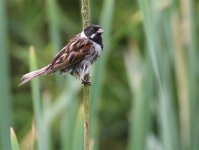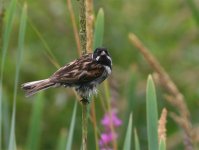Holmethorpe Sand Pits
This is a large area of worked out sand pits seven miles to the north east of our home, to the east of Redhill, south east of Merstham. The site starts immediately to the south west of the M25/M23 junction (traffic noise is unbelievable) with a pit called Spynes Mere, which is now run by the Surrey Wildlife Trust. There's another large pit immediately to the west of this which is still being worked - I don't know what this is called.
There's a bridleway that runs between these two pits, and if you follow this south through a large arable field and some pony paddocks you come to Mercers Country Park, with the oldest established worked out pit. This area used to be very good for birds, but unfortunately, there is now such a wide area of tree and scrub cover round the lake that it's not at all good for birdwatchers. The only people who have access to the lake shore are fishermen, and people using the watersports centre. It is possible to set up a telescope at the sports centre at the eastern end, but you can't really see very much.
Carrying on in a westerly direction past Mercers Lake and across Cormongers Lane, there's another Surrey Wildlife reserve based on more worked out sandpits called The Moors. And south of that is an enormous landfill site, that apparently attracts gulls in winter, but we've never been able to work out where you can actually see on to it.
Anyway, yesterday evening we managed to get up to Spynes Mere for an hour. Last year, this was quite a good place for waders, but this year they're pumping water out of the sandpit to the west into Spynes Mere, making the water levels so high that there's virtually no edging here to attract waders. So apart from a few of the more normal ducks and geese there wasn't much else.
We went down into the arable field where there are some beautiful old oak trees. We saw a pair of little owls here in May, but the leaf cover is much denser now, and, although I'm sure they were there, there was no sign of them.
Going back north again, on an island in the pit to the west of Spynes Mere, we could see two unknown birds - they were at the extreme edge of our telescope's range, so we whizzed round there and were delighted to find they were juvenile common terns, with one of their parents. This to us was really exciting news. I know they nest inland, but we've never seen them anywhere but on the coast at migration times before, so to find them on a local patch is lovely.
Close to them were five Egyptian Geese (we saw 11 in the same place last year), and a single lapwing - there was a large flock here last winter, so maybe this is the first returning one.
The complete list of what we saw/heard in one hour:
Collared dove 4
little grebe 9
swift 36
woodpigeon 18
magpie 3
greenfinch
mallard 8
green woodpecker 3
tufted duck 4
grey heron 3
coot c.80
mute swan 13
greylag 37
moorhen 5
carrion crow 5
barn swallow 3
house martin 6
great tit
blackbird 2
sand martin 5
common tern 4
jay
wren
canada goose 2
black headed gull
Egyptian goose 5
feral pigeon 3
lapwing.
28 species in one hour.





